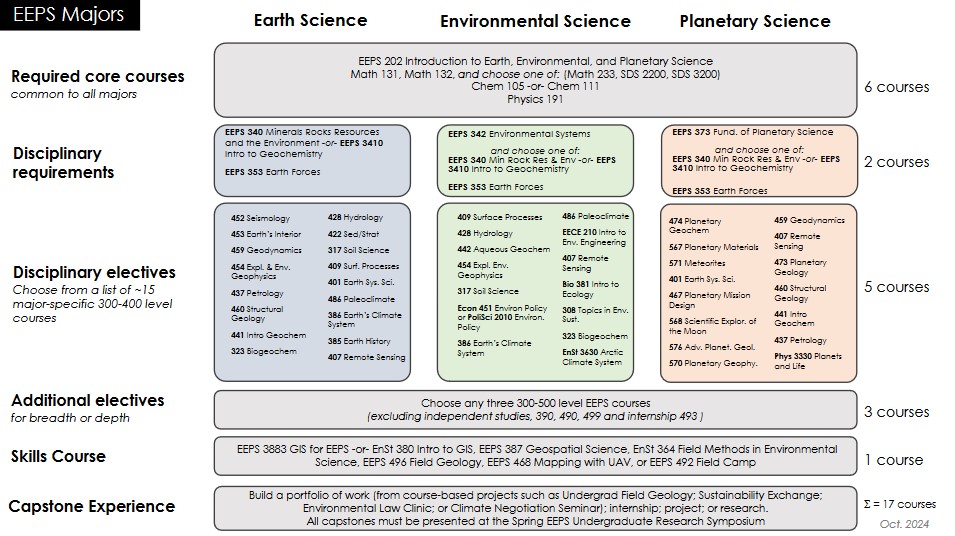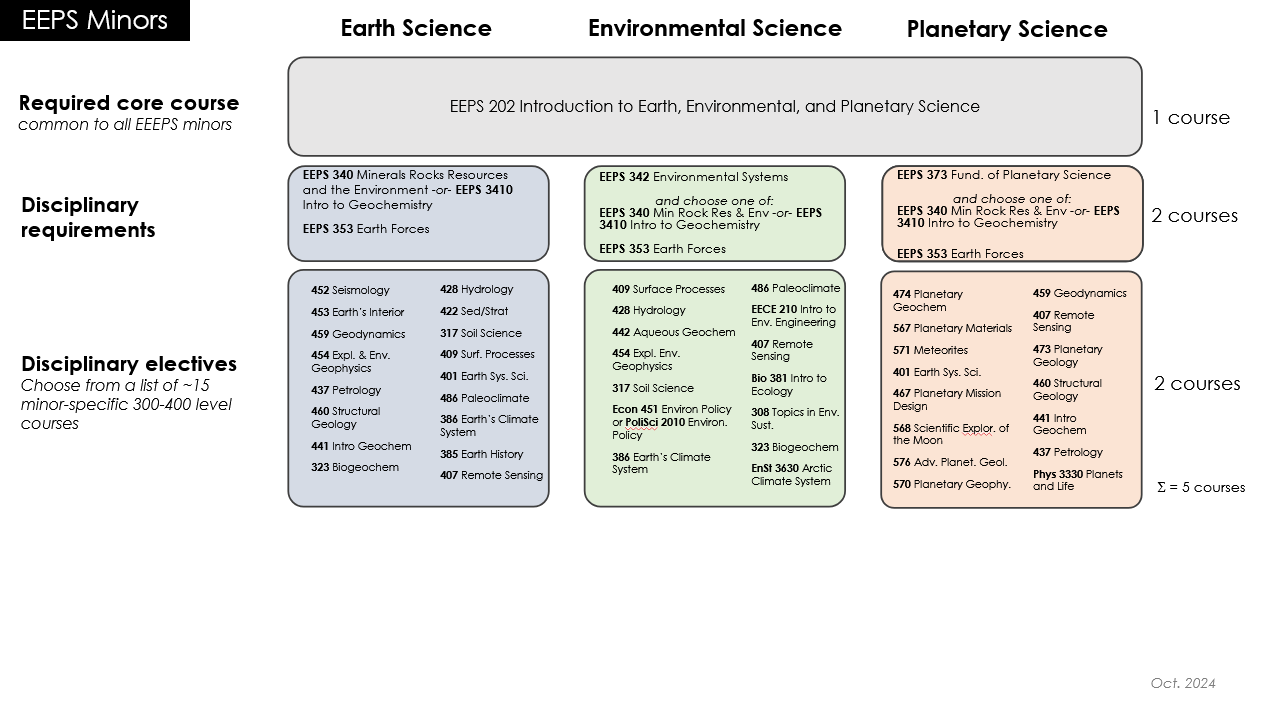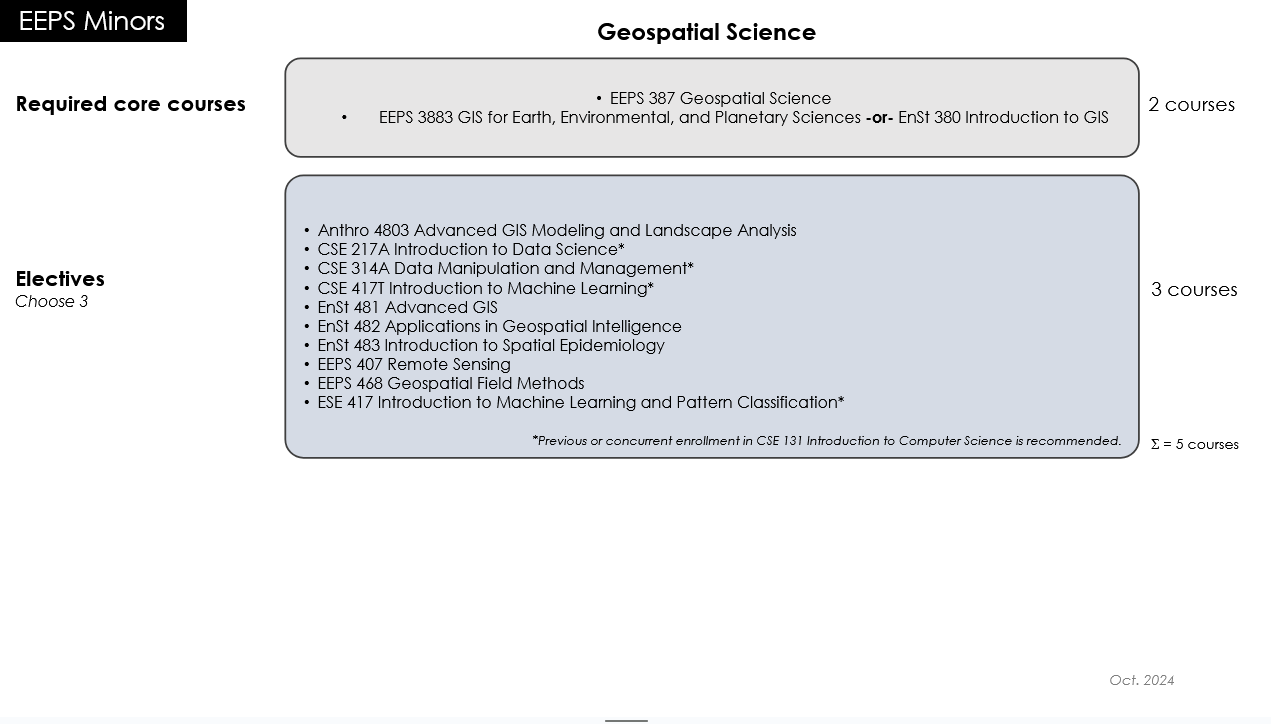*New for Fall 2022!*
The Department of Earth, Environmental, and Planetary Sciences has introduced a new set of majors and minors in Earth Science, Environmental Science, and Planetary Science. The goal of these new programs is to provide greater interdisciplinarity and flexibility, while preparing students for a variety of careers in government, business, NGOs, and research.
Students who matriculated in FL21 or earlier are entitled to continue with the major / minor they have already declared. However, all students are encouraged to consider these new opportunities. For more details on each of the majors, please consult the Bulletin or review the list below. Please contact Phil Skemer (Professor and Director of Undergraduate Studies) for more information.
Earth Science Major
Earth Science is the application of natural science and mathematics to the study of the planet Earth, its formation, structure, evolution, and geologic hazards.
Required Courses
EEPS 202 Introduction to Earth, Environmental, and Planetary Science.
Math 131,132, and choose one of: (Math 233, SDS 2200, SDS 3200)
Chem 105 -OR- Chem 111
Physics 191
Disciplinary Requirements: ( 2 Courses )
- EEPS 340 Minerals, Rocks, Resources and the Environment -OR- EEPS 3410 Intro to Geochemistry
- EEPS 353 Earth Forces
Disciplinary Electives: ( 5 Courses)
- EEPS 317 Soil Science
- EEPS 323 Biogeochemistry
- EEPS 385 Earth History
- EEPS 386 The Earth's Climate System
- EEPS 401 Earth Systems Science
- EEPS 407 Remote Sensing
- EEPS 409 Surface Processes
- EEPS 422 Sedimentary Geology
- EEPS 428 Hydrology
- EEPS 437 Igneous and Metamorphic Petrology
- EEPS 441 Introduction to Geochemistry
- EEPS 452 Introduction to Seismology
- EEPS 453 Interior of the Earth
- EEPS 454 Exploration and Environmental Geophysics
- EEPS 459 Geodynamics
- EEPS 460 Introduction to Structural Geology
- EEPS 486 Paleoclimatology
Additional Electives ( for breadth or depth) - Choose any three 300 - 500 level EEPS courses (excluding EEPS 390, 490, 499 and internship 493) = 3 Courses
Skill Course: EEPS 3883 GIS for Earth, Environemental, and Planetary Sciences - OR- EnSt 380 Applications in GIS Geospatial Science, EnST 364 Field Methods in Environmental Science, EEPS 496 Field Geology, EEPS 468 Geospatial Fields Methods, or EEPS 492 Field Camp = 1 Course
Capstone Experience: Build a portfolio of work from course based projects (such as Field Geology, Sustainability Exchange, Environmental Law Clinic, or Climate Negotiation Seminar), internship experience, or research. All capstones must be presented at the Spring EEPS Undergraduate Research Symposium = 17 Courses
Environmental Science Major
Environmental Science is the scientific investigation of natural systems including the hydrosphere, cryosphere, atmosphere, ecosystems, and landscapes which sit at the intersection of the Earth and humanity.
Required Courses
EEPS 202 Introduction to Earth, Environmental, and Planetary Science.
Math 131,132, and choose one of: (Math 233, SDS 2200, SDS 3200)
Chem 105 -OR- Chem 111
Physics 191
Disciplinary Requirements: ( 2 Courses )
- EEPS 342 Environmental Systems (and choose one of):
- EEPS 340 Minerals, Rocks, Resources and the Environment -OR- EEPS 3410 Intro to Geochemistry
- EEPS 353 Earth Forces
Disciplinary Electives: ( 5 Courses)
- EECE 210 Introduction to Energy, Environmental, and Chemical Engineering
- Bio 381 Introduction to Ecology
- EEPS 308 Topics in Environmental Sustainability
- EEPS 317 Soil Science
- EEPS 323 Biogeochemistry
- EEPS 386 The Earth's Climate System
- EEPS 407 Remote Sensing
- EEPS 409 Surface Processes
- EEPS 428 Hydrology
- EEPS 442 Aqueous Geochemistry
- Econ 451 Environmental Policy or PoliSci 2010 Introduction to Environmental Policy
- EEPS 454 Exploration and Environmental Geophysics
- EEPS 486 Paleoclimatology
- EnSt 3630 Arctic Climate System
Additional Electives (for breadth or depth) - Choose any three 300 - 500 level EEPS courses (excluding EEPS 390, 490, 499 and internship 493) = 3 Courses
Skill Course: EEPS 3883 GIS for Earth, Environemental, and Planetary Sciences -OR- EnSt 380 Applications in GIS Geospatial Science, EnST 364 Field Methods in Environmental Science, EEPS 496 Field Geology, EEPS 468 Geospatial Fields Methods, or EEPS 492 Field Camp = 1 Course
Capstone Experience: Build a portfolio of work from course based projects (such as Field Geology, Sustainability Exchange, Environmental Law Clinic, or Climate Negotiation Seminar), internship experience, or research. All capstones must be presented at the Spring EEPS Undergraduate Research Symposium = 17 Courses
Planetary Science Major
Planetary Science uses the tools of geoscience and geospatial analysis to study objects in the solar system, including planets, moons, and meteorites.
Required Courses
EEPS 202 Introduction to Earth, Environmental, and Planetary Science.
Math 131,132, and choose one of: (Math 233, SDS 2200, SDS 3200)
Chem 105 -OR- Chem 111
Physics 191
Disciplinary Requirements: ( 2 Courses )
- EEPS 373 Fundamentals of Planetary Science (and choose one of):
- EEPS 340 Minerals, Rocks, Resources and the Environment -OR- EEPS 3410 Intro to Geochemistr
- EEPS 353 Earth Forces
Disciplinary Electives: ( 5 Courses)
- EEPS 401 Earth Systems Science
- EEPS 407 Remote Sensing
- EEPS 437 Igneous and Metamorphic Petrology
- EEPS 441 Introduction to Geochemistry
- EEPS 459 Geodynamics
- EEPS 460 Introduction to Structural Geology
- EEPS 467 Planetary Mission Design
- EEPS 473 Planetary Geology
- EEPS 474 Planetary Geochemistry
- EEPS 567 Planetary Materials
- EEPS 568 Scientific Exploration of the Moon
- EEPS 570 Planetary Geophysics and Dynamics
- EEPS 576 Advanced Planetary Geology: Ice Worlds
- Phys 3330 Planets and Life In the Universe
Additional Electives ( for breadth or depth) - Choose any three 300 - 500 level EEPS courses (excluding EEPS 390, 490, 499 and internship 493) = 3 Courses
Skill Course: EEPS 3883 GIS for Earth, Environemental, and Planetary Sciences -OR- EnSt 380 Applications in GIS Geospatial Science, EnST 364 Field Methods in Environmental Science, EEPS 496 Field Geology, EEPS 468 Geospatial Fields Methods and GPS course, or EEPS 492 Field Camp = 1 Course
Capstone Experience: Build a portfolio of work from course based projects (such as Field Geology, Sustainability Exchange, Environmental Law Clinic, or Climate Negotiation Seminar), internship experience, or research. All capstones must be presented at the Spring EEPS Undergraduate Research Symposium = 17 Courses
Minor in Earth Science
Required Courses
EEPS 202 Introduction to Earth, Environmental and Planetary Science = 1 course
Disciplinary Requirements: ( 2 Courses )
- EEPS 340 Minerals, Rocks, Resources and the Environment -OR- EEPS 3410 Intro to Geochemistry
- EEPS 353 Earth Forces
Disciplinary Electives: ( 2 Courses)
- EEPS 317 Soil Science
- EEPS 323 Biogeochemistry
- EEPS 385 Earth History
- EEPS 386 The Earth's Climate System
- EEPS 401 Earth System Science
- EEPS 407 Remote Sensing
- EEPS 409 Surface Processes
- EEPS 422 Sedimentary Geology
- EEPS 428 Hydrology
- EEPS 437 Igneous and Metamorphic Petrology
- EEPS 441 Introduction to Geochemistry
- EEPS 452 Introduction to Seismology
- EEPS 453 Interior of the Earth
- EEPS 454 Exploration and Environmental Geophysics
- EEPS 459 Geodynamics
- EEPS 460 Introduction to Structural Geology
- EEPS 486 Paleoclimatology
Minor In Environmental Science
Required Courses
EEPS 202 Introduction to Earth, Environmental and Planetary Science = 1 course
Disciplinary Requirements: ( 2 Courses )
- EEPS 342 Environmental Systems ( And choose one of the following):
- EEPS 340 Minerals, Rocks, Resources and the Environment -OR- EEPS 3410 Intro to Geochemistry
- EEPS 353 Earth Forces
Disciplinary Electives: ( 2 Courses)
- Bio 381 Introduction to Ecology
- Econ 451 Environmental Policy or PoliSci 2010 Introduction to Environmental Policy
- EECE 101 Introduction to Energy, Environmental, and Chemical Engineering
- EEPS 308 Topics in Environmental Sustainability
- EEPS 317 Soil Science
- EEPS 323 Biogeochemistry
- EEPS 386 The Earth's Climate System
- EEPS 407 Remote Sensing
- EEPS 409 Surface Processes
- EEPS 428 Hydrology
- EEPS 442 Aqueous Geochemistry
- EEPS 454 Exploration and Environmental Geophysics
- EEPS 486 Paleoclimatology
- EnSt 3630 Arctic Climate System
Minor in Planetary Science
Required Courses
EEPS 202 Introduction to Earth, Environmental and Planetary Science = 1 course
Disciplinary Requirements: ( 2 Courses )
- EEPS 373 Fundamentals of Planetary Science (and choose one of):
- EEPS 340 Minerals, Rocks, Resources and the Environment -OR- EEPS 3410 Intro to Geochemistry
- EEPS 353 Earth Forces
Disciplinary Electives: ( 2 Courses)
- EEPS 401 Earth Systems Science
- EEPS 407 Remote Sensing
- EEPS 437 Igneous & Metamorphic Petrology
- EEPS 441 Introduction to Geochemistry
- EEPS 459 Geodynamics
- EEPS 460 Introduction to Structural Geology
- EEPS 467 Planetary Mission Design
- EEPS 473 Planetary Geology
- EEPS 474 Planetary Geochemistry
- EEPS 567 Planetary Materials
- EEPS 568 Scientific Exploration of the Moon
- EEPS 570 Planetary Geophysics & Dynamics
- EEPS 576 Advanced Planetary Geology: Ice Worlds
Minor in Geospatial Science
Required Courses
Disciplinary Requirements: ( 2 Courses )
- EEPS 387 or EEPS 587 Geospatial Science
- EEPS 3883 GIS for Earth, Environemental, and Planetary Sciences -OR- Enst 380 Applications in GIS
Disciplinary Electives: (3 Courses)
- Anthro 4803 Advanced GIS Modeling and Landscape Analysis
- CSE 217A Introduction to Data Science *
- CSE 314A Data Manipulation and Management *
- CSE 417T Introduction to Machine Learning *
- EEPS 407 Remote Sensing
- EEPS 468 Geospatial Field Methods
- EnSt 481 Advanced GIS
- EnSt 482 Applications in Geospatial Intelligence
- EnSt 483 Introduction to Spatial Epidemiology
- ESE 417 Introduction to Machine Learning and Pattern Classification *
* Previous or concurrent enrollment in CSE 131 Introduction to Computer Science is recommended.
If you are an undergraduate who entered Washington University in FL21 or earlier and do not see your degree program listed, please visit our Prior Majors page here.



